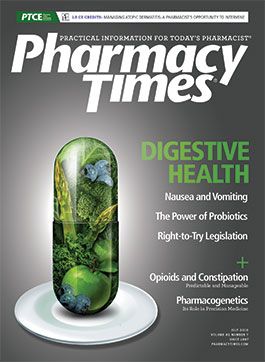"Contraindication" Versus "Avoid Concomitant Use"
In the official prescribing information of pharmaceutical products, drug interactions are often listed in 2 categories: contraindicated" and avoid concomitant use." Is this a distinction without a difference?
In the official prescribing information of pharmaceutical products, drug interactions are often listed in 2 categories: “contraindicated” and “avoid concomitant use.” Is this a distinction without a difference? The Medline Plus definition of “contraindication” is “…a specific situation in which a drug, procedure, or surgery should not be used because it may be harmful to the person.” Other official definitions are similar to this, which raises the question, how is this different from “avoid concomitant use?” Let us explore this issue using, as an example, ivabradine (Corlanor), a drug used to treat heart failure.
INTERACTIVE PROPERTIES OF IVABRADINE
Ivabradine is primarily metabolized by CYP3A4 in the gut and liver, and its bioavailability is only about 40% due to first-pass metabolism. Inhibitors of CYP3A4 can substantially increase ivabradine plasma concentrations through reduction in first-pass metabolism and systemic metabolism of CYP3A4 by the liver. 1 As expected, CYP3A4 inducers can substantially reduce the bioavailability of ivabradine.
Because ivabradine slows the heart rate, it can cause additive bradycardia with the use of other drugs that slow the heart rate, such as digoxin and amiodarone. (Note that beta-blockers are usually given concurrently with ivabradine, so that is not considered a drug interaction.) Isolated case reports have appeared suggesting that the risk of torsades de pointes may be increased when ivabradine is combined with drugs such as diltiazem plus ranolazine or azithromycin, but additional evidence is needed to assess the clinical importance of these purported interactions.2,3
“CONTRAINDICATED” INTERACTIONS
The product information for ivabradine lists concurrent use of “strong CYP3A4 inhibitors” as contraindicated. Although no specific details of the studies are given, the data presented show that the potent CYP3A4 inhibitor ketoconazole increases ivabradine area under the curve (AUC) by approximately 7-fold. “AVOID CONCOMITANT USE” INTERACTIONS The product information for ivabradine also presents data suggesting that “moderate” CYP3A4 inhibitors, such as diltiazem and verapamil, can produce a mean increase in the ivabradine AUC of approximately 2- to 3-fold. It also lists St. John’s wort and other CYP3A4 inducers in this category; data show a 62% decrease in the ivabradine AUC with the use of St. John’s wort and an 80% decrease with the use of carbamazepine.4,5
PRACTICAL CONSIDERATIONS
With regard to ivabradine drug interactions, is there a practical difference between the designations of “contraindicated” and “avoid concomitant use?” First, regarding CYP3A4 inducers, it could be argued that they should never be given with ivabradine because ivabradine plasma concentrations would almost always be subtherapeutic. Thus, it would seem that CYP3A4 inducers might be best listed as “contraindicated” rather than under “avoid concurrent use.”
Regarding “strong” CYP3A4 inhibitors, given that ivabradine has potentially serious dose-dependent adverse cardiovascular effects, it seems reasonable to make every effort to avoid ketoconazole and other “strong” CYP3A4 inhibitors. (Itraconazole, clarithromycin, telithromycin, nelfinavir, and nefazodone are listed, but there are others.) It is conceivable, however, that a prescriber might—under very special circumstances— weigh the benefits versus the risks and choose to give one of the strong inhibitors while carefully monitoring for ivabradine toxicosis (possibly also with a reduction in ivabradine dose). So, it might be difficult to argue, for example, that “under absolutely no circumstances whatsoever should ivabradine ever be given with clarithromycin.”
Regarding “moderate” CYP3A4 inhibitors such as diltiazem or verapamil, it is reasonable to assume that the risk average is less than the risk of giving ketoconazole with ivabradine. However, we know there is substantial overlap regarding the danger of “strong” versus “moderate” CYP3A4 inhibitors, depending on a host of factors involving various patient characteristics and the dosage regimens of the 2 drugs. Of 2 patients on ivabradine, one may be given a strong CYP3A4 inhibitor with no adverse effects and another given a moderate CYP3A4 inhibitor followed by a life-threatening reaction.
SUMMARY
Among patients on ivabradine, it would clearly be best to avoid “strong” and “moderate” CYP3A4 inhibitors. The decision to use either type of inhibitor should be made with full consideration of the benefits and risks, and with close monitoring for ivabradine adverse effects. It is hard to imagine a scenario in which a CYP3A4 inducer would be justified in a patient on ivabradine.
Drs. Horn and Hansten are both professors of pharmacy at the University of Washington School of Pharmacy. For an electronic version of this article, including references, if any, visit www.hanstenandhorn.com.
References
- Corlanor [package insert]. Thousand Oaks, CA: Amgen Inc; 2015.
- Mittal SR. Slow junctional rhythm, QTc prolongation and transient torsades de-pointes following combined use of ivabradine, diltiazem and ranolazine. J Assoc Physicians India. 2014;62(5):426-427.
- Cocco G, Jerie P. Torsades de pointes induced by the concomitant use of ivabradine and azithromycin: an unexpected dangerous interaction. Cardiovasc Toxicol. 2015;15(1):104-106. doi: 10.1007/s12012-014-9274-y.
- Portolés A, Terleira A, Calvo A, Martinez I, Resplandy G. Effects of Hypericum perforatum on ivabradine pharmacokinetics in healthy volunteers: an open-label pharmacokinetic interaction clinical trial. J Clin Pharmacol. 2006;46(10):1188-1194.
- Vlase L, Neag M, Popa A, Muntean D, Baldea I, Leucuita SE. Pharmacokinetic interaction between ivabradine and carbamazepine in healthy volunteers. J Clin Pharm Ther. 2011;36(2):225-229. doi: 10.1111/j.1365-2710.2010.01170.x.
Drs. Horn and Hansten are both professors of pharmacy at the University of Washington School of Pharmacy. For an electronic version of this article, including references, if any, visit www.hanstenandhorn.com.

